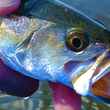Side channels rock.
I was 11 years old when Messrs. Page, Plant, Jones and Bonham - Led Zeppelin, for those of you who don’t know - released one of the great rock & roll anthems of all time. Stairway to Heaven was an instant classic, and it still blasts from car speakers and home stereos all over the world. I was actually listening to the song the other day when the lyrics, which I’ve probably heard a thousand times over the last 40 odd years, jumped the tracks and made a new connection in my brain.
"Yes, there are two paths you can go by, but in the long run, there's still time to change the road you're on."
I’ve always loved that overt reference to choice and self-determination, but it never occurred to me, at least not until recently, that our paths through life take different forms, and that every time the river forks we can choose a new way forward.
Looking back, I’ve almost always taken the less direct route; the side channel that wanders off from the main river and into a world of infinite possibilities. And while that may sound like a metaphor for the personal choices I’ve made over the years, it’s also a pretty straightforward blueprint for my trout fishing. Side channels are where two disparate, never-the-twain-shall-meet experiences come together in what often turns out to be the perfect mix.
Think about that for a second. An awful lot of us love to fish small streams. They’re typically easier to wade than big rivers, and easier to read, and in many cases they combine natural beauty with just the right amount of fly fishing intimacy. Put another way, little creeks and streams can be magical.
More Like This
What they don’t typically offer, though, is big fish. While there are exceptions to the rule, most streams and creeks hold smaller trout (or bass, or whatever) than you’ll find if you target larger waters. That’s just the way it works, and it’s okay with most of us; it’s a reasonable trade-off.
Only - and this is where things get interesting - that particular trade-off doesn’t always apply to side channels. There are any number of major river systems where a part of the flow slips away from the main stem and turns into something completely different. Maybe that runaway water becomes a gorgeous little freestone creek for a quarter mile before rejoining the river, or perhaps it braids into a classic riffle/run/pool configuration for a few hundred yards, or it could even morph into a mile of gorgeous spring creek. Almost invariably, though, a few of the river’s larger fish will decide to head off the beaten path and take up residence in what, for all intents and purposes, is a beautiful little stream.
Back in my guiding days, I used to take anglers to a short side channel on the Madison. Most of us, of course, think of the Madison from Slide Inn to Ennis as one long, wide, 50 mile riffle. It’s classic Big Sky water, with plenty of room to cast and some awfully nice trout - but it’s a far cry from intimate. That little channel, though, was entirely different. A dense coniferous forest grew right down to the water’s edge on both sides of the channel, and brown trout - big browns - would hide in the gnarled root clusters that spread, Medusa-like, below the water line along both banks. Wading there was like wading Faerie-land - it was always dark and cool in that forest - and we’d wander down the middle of the channel and float big attractor patterns against the banks, knowing that we’d likely take three or four really nice brown trout in an hour or less.
That type of experience replicates itself on many of the best western rivers. We used to fish a side channel of the Elk that was literally within spitting distance of downtown Fernie, BC. The channel itself wasn’t more than thirty feet across in some places, but those oversized Elk River cutthroats would swim in from the main stem and take up residence in the deeper water near a handful of bank-side boulders. Even better, they’d rise freely in the shade of overhanging cottonwoods at the same time their main-stem brethren sulked under the glare of the mid- summer sun. The drift boat brigade, which invariably stuck to the main channel, had no idea what was going on in that tiny fork of the river.
One of my favorite side channels is on the Missouri. There’s a spot where, if you’re floating downstream, the main river veers left and a smaller channel sneaks off to the right. It’s wide - maybe 30 yards in places - and shallow, and it looks like an oversized spring creek. If you’ve fished the Paradise Valley spring creeks, just imagine Armstrong’s with two or three times the volume of water. Or if you’ve spent time on the Henry’s Fork, it’s almost as if you’re exploring a narrow stretch of the Railroad Ranch. Really big fish eat the bugs de jour - typically caddis or mayflies or midges - with, if not abandon, then a certain comfortable regularity.
No, they’re not easy to fool, or catch, but how many places do you know where you can cast dry flies to really large wild browns and rainbows feeding on the surface in less than two feet of water? Without, I should add, paying a hundred dollars or more per day as a rod fee?
Last spring I was down on that particular channel with Pat McCabe. This might sound surreal, but we had a day when the wind died, the sun hid behind gray skies, and everything was just perfect. And by perfect, I mean there were big trout dimpling the surface for as far as the eye could see; most of them sipping mayfly spinners, with the occasional fish taking PMD duns or crippled caddis. There were a couple of other anglers around, but there were always more fish than we could cast to and we must have spent 5 or 6 hours in ... well, if it wasn’t heaven, it was as close as you can get on this earthly plane. The air was rich and fragrant, the landscape was shifting from that surging electric green of early spring to the deeper, darker shade that marks the onset of summer, and the trout, who tend to be awfully tough, were generous to a fault.
At the peak of things, with Pat working a dandy fish down below me and a dozen nice trout rising within casting distance, I heard a shout from the top end of the channel. I believe it was an angler telling his fishing partner about the huge rainbow he’s just hooked, but looking back, filtered through the prism of the intervening months, I can almost convince myself that he was singing rather than shouting.
And if was he was singing ... well, likely as not, he was doing his best Robert Plant imitation and belting out Stairway to Heaven.
Side channels rock.





























Comments
Dennis Swentosky replied on Permalink
Nice. I enjoyed that one a lot, Todd.
Eric replied on Permalink
Yeah, side channels are where it's at. Back in the backcountry . . .
Pages